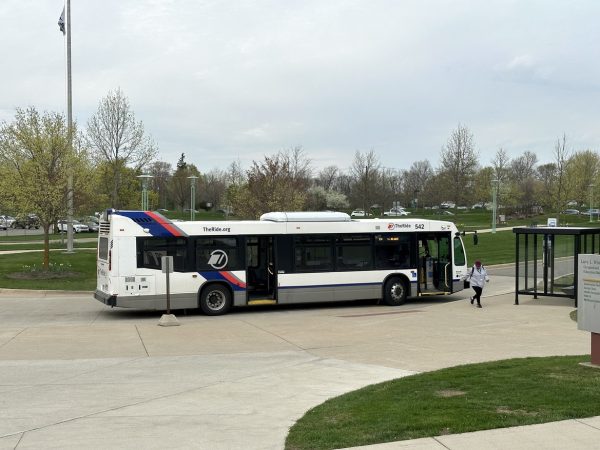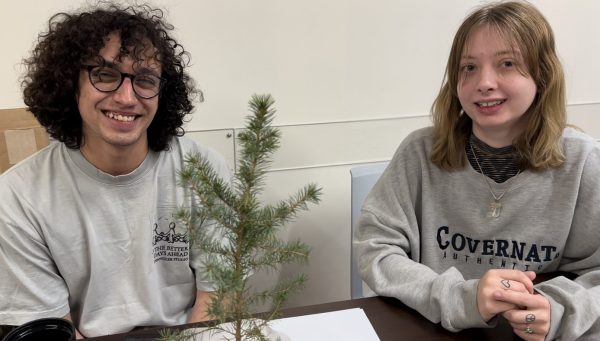
TheRide’s bus 542 stops in the Student Center’s drive-in loop, where a student exits toward the Larry L. Whitworth Occupational Building. Willow Symonds | Washtenaw Voice
By Willow Symonds
Staff Writer
Despite living in Washtenaw County all 21 years of her life, graphic design student Crystal Mendoza has never used the AAATA (Ann Arbor Area Transportation Authority) buses.
“I don’t really know how the bus system works,” Mendoza said. “I’ve tried to learn it, but it’s a little too complicated for me. Reading their maps gives me a migraine.”
Driving to WCC’s campus takes her roughly five to 10 minutes, which she feels costs less money than using the bus multiple times a week.
But not all students live so close to campus. 3D animation student Strider Toll resides in Livingston County and drives almost 40 minutes to WCC – and that’s without traffic. To avoid commuting, which requires gas money and time, he takes mostly online and virtual classes.
“If I could take a bus to WCC from my house (in) a reasonable amount of time, I think I would’ve come to campus for clubs more often,” Toll said.
Gasoline-powered vehicles – like cars, SUVs, and pick-up trucks – use fossil fuels and create 29% of the U.S.’s greenhouse gasses, according to the Federal Transit Administration. Sunrise Ann Arbor, a chapter of environmental activist group the Sunrise Movement, hopes to limit car usage by making bus systems accessible to all.
Two days before Earth Day, Sunrise Ann Arbor managed a booth in the Student Center. Two members answered students’ questions while encouraging them to take a survey on public transit. This form asked students about their transportation modes and what would motivate them to instead use the bus – specifically, AAATA’s bus system, TheRide.
Sunrise Ann Arbor chose WCC’s campus due to the “disparity between UofM students having access to free rides on the ride service, [which is] not something available to Washtenaw students,” said Sunrise Ann Arbor member and WCC student Hunter Carlson.
TheRide’s Route 24 (Eisenhower-Golfside) and Route 3 (Huron) buses stop in the Student Center’s looped drive-in every half hour. WCC’s Cashier Desk offers students, staff, and faculty $45 bus passes, which provide any amount of rides in 30 consecutive days.
One WTMC student who doesn’t drive but uses a bus pass is Amal Said, who travels with it “at least once a week.”
“For public transportation, it’s pretty solid,” she said, noting cleanliness as one of TheRide’s strengths. “(Using it) is a bit harder the further you get from downtown, but they go to most areas in Ann Arbor and to both the Ypsi and Detroit Transit Centers.”
Said recommends TheRide Bus Tracker, an app where users can select a route, a direction, and a stop. The website has the same features, though the app saves one’s “favorite” routes.
WCC student Grey Kangas has never bought a bus pass, but they believe TheRide is accessible to disabled passengers. As an example, they mentioned the ramp extension leading to the door and the front seats designed for wheelchair users. Announcements in both visual and audio forms tell hard-of-hearing and visually impaired passengers the intersection names and alert them when fellow riders request stops.
Even with these accommodations, disabled passengers have another option: The A-Ride. The A-Ride bus is for those who are limited from using the regular ride or walking the distance to the regular ride’s stops.
“It’s curb to curb, so we pick up the individual,” said Tracy Byrd, TheRide’s mobility service coordinator and travel trainer.
The A-Ride makes 350 trips per day, according to Byrd, though 3% of those riding the regular buses have an A-Ride identification card.
“If the disability is not limiting, then it’s not for A-Ride,” she explained, using arthritis as an example. “It may hurt from time to time, and it may make it hard to walk, but it doesn’t count for an (A-Ride) ID card. If further down the road it prevents (them) from getting to the bus stop, then (they) might be eligible.”
Disabled individuals can also apply for the Fair Deal Program, which discounts one’s fare to half price: $22.50. Passengers on the Fair Deal Program account for 2% of TheRide’s ridership, according to Byrd, and she stresses how those living in poverty and those ages 60 to 64 can qualify for the program.
To apply for the Fair Deal Program, one can arrive at the main office in 2700 S Industrial Hwy and present valid identification, such as a driver’s license, a passport, or a work ID. Applicants also need to show medical documentations approved by a medical professional.
TheRide’s getDowntown program hosts a Commuter Challenge this month to encourage community members in using more environmentally friendly means of transportation. This includes walking, biking, carpooling, and of course, using the bus.
However, using public transportation doesn’t just help the environment – it can also help its passengers. While Toll doesn’t use the bus himself, he notes that buses “reduce the risk of distracted driving.”
“You can watch a TV show or read a book while sitting in a bus,” he said. “It’s less isolating because you don’t need inches of metal between yourself and every other person.”
Senior policy analyst Wendy Heaps along with senior policy advisors Erin Abramsohn and Elizabeth Skillen – who all work in the Policy and Strategy, Centers for Disease Control and Prevention – wrote ‘Public Transportation In The US: A Driver Of Health And Equity.’ Their 2021 health policy brief explained how “expanded access to public transportation can … (increase) access to medical care, healthy food, vital services, employment, and social connections.”
Sunrise Ann Arbor hopes to overcome the challenges students like Toll and Mendoza face against using the bus, such as fare price, route location, and accessibility to apps and maps.

Two Sunrise Ann Arbor members and WCC students, Hunter Carlson and Kim Tieking, encourage their peers to use public transportation. Willow Symonds | The Washtenaw Voice


